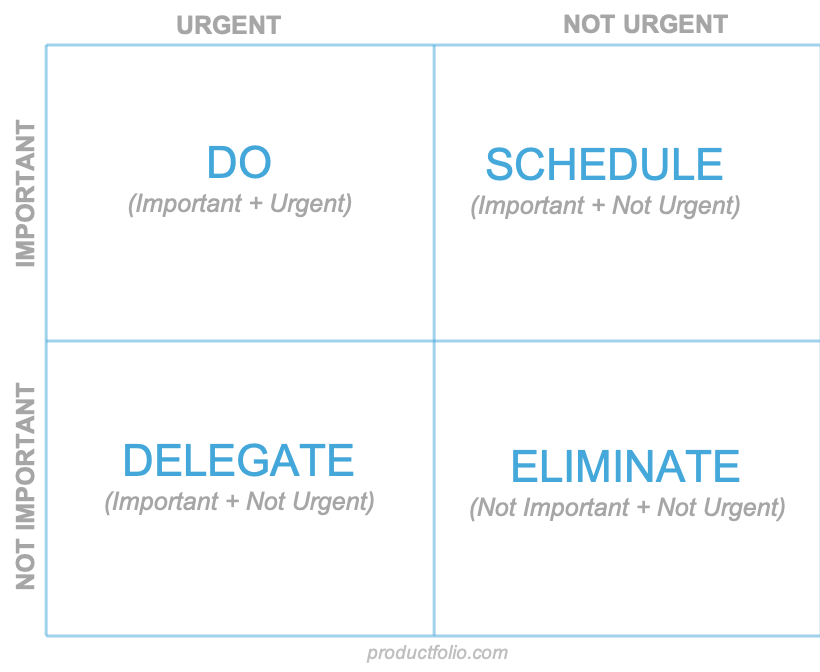What is the Eisenhower Matrix?
Product managers are usually very busy people. There is one task or another to attend to at a point time. If care is not taken, however, you may find that you’ve been laboring away with little to show for your efforts.
Effective prioritization is a hallmark of successful PMs. If you want to achieve more, you need to be able to clearly tell the difference between what is “urgent” and “important.” The Eisenhower Matrix is one tool that can help you do this effectively.

About the Eisenhower Matrix
The Eisenhower Matrix is a framework for prioritizing tasks based on their urgency and importance. It helps correct issues relating to poor time and task management. People also call it the Urgent-Important Matrix, Eisenhower Box, and Eisenhower Decision Matrix.
The prioritization framework takes its name after Dwight Eisenhower. The 34th president of the United States presented the idea underlying it. Eisenhower was renowned for his impressive focus and productivity at work while still having ample time for his hobbies.
Stephen Covey would popularize this matrix many years later with his 1989 book, “The 7 Habits of Highly Effective People.” The framework is now widely used in the business world for promoting good time management and efficiency.
What Does the Matrix Look Like?
The Urgent-Important Matrix comprises four quadrants or squares. These are created by drawing intersecting vertical and horizontal lines. The x-axis (horizontal) describes urgency while the y-axis (vertical) depicts importance. Items or tasks in the left column are urgent while those on the right side are not. Also, items in the top half are important while those below are not.
After drawing your matrix, you now need to arrange items in the quadrants according to their urgency and importance. Here’s what to include in each square:
Quadrant 1 (top-left) – Items that are urgent and important
Quadrant 2 (top-right) – Items that are not urgent but important
Quadrant 3 (bottom-left) – Items that are urgent but not important
Quadrant 4 (bottom-right) – Items that are neither urgent nor important
The Eisenhower Matrix looks very simple. But it has proven that the most helpful tools aren’t always those that have complex parts.
How to Achieve More with the Eisenhower Matrix
Eisenhower is often quoted as saying, “What is important is seldom urgent, and what is urgent is seldom important.” This is the so-called Eisenhower Principle.
If you take a look at the Urgent-Important Matrix, you’d certainly agree that what is important isn’t always that which is urgent. Product managers, however, could easily miss this point with a long and growing list of things to do.
Let’s consider how you can put this framework to good use and be more productive by focusing on what matters most.
Top-left quadrant
Items in this section are the ones that should have your attention. When you look at all the tasks before you, this should be the ones that get your focus to work on immediately.
The tasks here are usually those that are critical or have deadlines that you cannot afford to miss. They could also be those that require your expertise to be carried out.
Top-right quadrant
The items or tasks here are important but are not urgent. So you can afford to put them off until a later time, and you should do that.
They are part of what you need to do, but they are just not that pressing yet. An example is something that can advance you professionally or contribute to a long-term goal.
Covey used exercise as an example of a task that is important but not urgent. The benefits are long-term. If you don’t exercise today, you could create time to do that later.
However, when you are drawing close to a deadline or critical stage, a task here moves to the first quadrant.
Bottom-left quadrant
This section has tasks that are urgent but not important. These are among those that can potentially take the most of a PM’s time with little to show. They perfectly justify Eisenhower’s statement that urgent tasks are seldom important.
Therefore, you do not want to devote your precious time to tasks in this quadrant. You should instead delegate them to others to handle. They are usually those types anyone else but you can attend to. An example is responding to certain urgent emails.
If feasible, you can use software to execute these tasks. A “No” answer won’t also be out of place, say, when a colleague asks for help, to avoid interruptions.
Bottom-right quadrant
You won’t fare worse if you decided to ignore items in this square or leave them until you have free time. They are neither important nor urgent, simply time-wasters.
The tasks that fall into this category are typically those that are not related to your work. They include using social media, browsing online deals, or playing games during work hours.
It should be noted, though, that some tasks that appear to be work-related can belong to this quadrant. An example is when spending extra time making things look “professional” even when not necessary for understanding.
With the Eisenhower Matrix, it becomes clearer what to pay attention to first. The framework enables effective prioritization.


